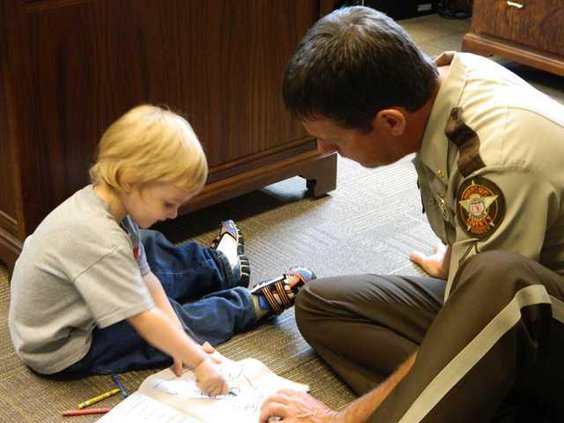Members of a Fort Stewart family said they will sleep easier knowing their child could be found within minutes if he wanders off.
Rhyse Crawford, 3, was diagnosed with autism in January, and his mother Lori worried her son could wander off.
“We have a hook-and-eye latch on his door because he would get out at night,” she said. “And if he was to get lost and someone came up to him and asked him questions, he wouldn’t be able to tell them who his mom is or where he lives.”
Crawford said she was so worried, the family moved last week to get away from nearby water.
“He was always trying to go to the pond across the street, and we have had to chase him down the road sometimes,” she said.
On Tuesday, her son became the third child to sign up with the county’s Project Lifesaver.
The project is designed to rescue people with cognitive conditions who tend to wander. Project Lifesaver works with law enforcement agencies and is in use across the country.
Clients wear a wristwatch-sized radio transmitter. The transmitter’s signal can be tracked regardless of where the person is. If a client is reported missing, trained searchers are sent to the area with receivers.
In March 2011, the LCSO started the project here after Sheriff Steve Sikes read about it. There currently are six deputies trained in the program.
The Crawfords learned about Project Lifesaver at an Autism Support Group Meeting.
“We were invited to the Army Community Service Autistic Support Group and I spoke for about 45 minutes to the families about Project Lifesaver,” LCSO Capt. David Edwards said.
Edwards said LCSO is collaborating with Fort Stewart.
“We agreed to help them out until they are able to get their own program up and running,” he said. “I have received a couple of calls from families from Fort Stewart so it’s possible we will get more families signed up too.”
Deputy Shawn Fields is one of the certified deputies. On Tuesday, he brought a coloring book for Rhyse Crawford, knowing he would be nervous with strangers. They played and colored until Fields was able to place the transmitter around the young boy’s ankle.
“Right now we have a 100 percent location rate,” the deputy said. “It also gives us one-on-one time with the kids. They get to know us and see we are much more than just law enforcement officers.”
Lori Crawford said she initially was skeptical.
“The first thing I thought was he would be able to take it off,” she said. “Honestly, because they are so smart, and he was able to take his whole crib apart so I thought he would be able to get this off. But I see it is a lot more durable than what I thought. They also reassured me that if he did get it off or if it stretched out, they could come out at any time to replace the bracelet.”
Crawford said she and her husband Matthew, a soldier with the 1st Brigade, 369 Armored Division, were worried about the initial $300 cost, but her family chipped in money as a gift.
“But if my family had not contributed I would have done the payment plan because it makes it more affordable,” she said.
Edwards said Project Lifesaver also offers grants.
For more information, call Edwards at 408-3106 or Project Lifesaver at 1-877-580-5433 or go to www.projectlifesaver.org.
Device helps find those who cant get home on own
LCSO teams up with Army to protect vulnerable people


Sign up for our e-newsletters